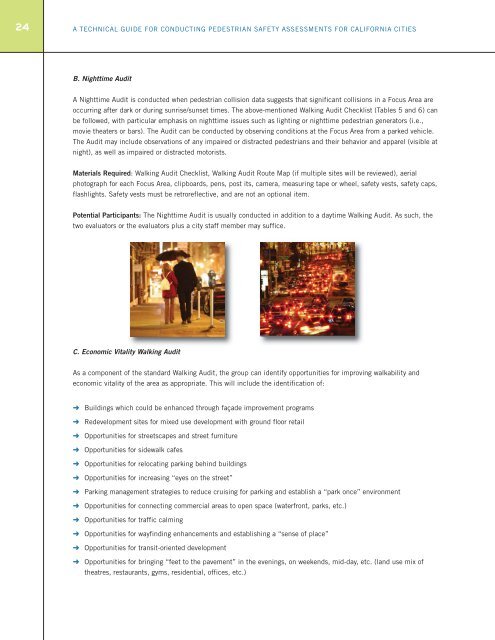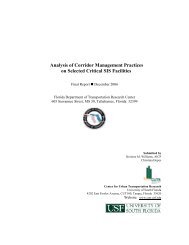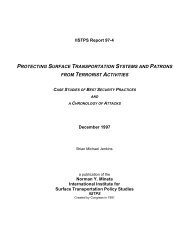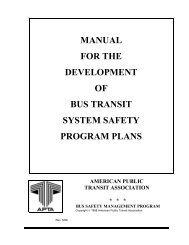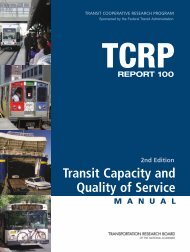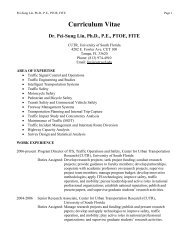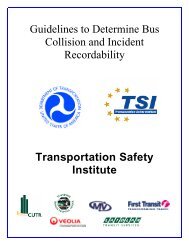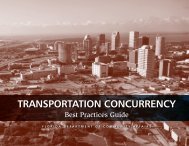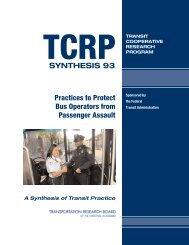a technical guide for conducting pedestrian safety assessments
a technical guide for conducting pedestrian safety assessments
a technical guide for conducting pedestrian safety assessments
Create successful ePaper yourself
Turn your PDF publications into a flip-book with our unique Google optimized e-Paper software.
24 A TECHNICAL GUIDE FOR CONDUCTING PEDESTRIAN SAFETY ASSESSMENTS FOR CALIFORNIA CITIES<br />
B. Nighttime Audit<br />
A Nighttime Audit is conducted when <strong>pedestrian</strong> collision data suggests that significant collisions in a Focus Area are<br />
occurring after dark or during sunrise/sunset times. The above-mentioned Walking Audit Checklist (Tables 5 and 6) can<br />
be followed, with particular emphasis on nighttime issues such as lighting or nighttime <strong>pedestrian</strong> generators (i.e.,<br />
movie theaters or bars). The Audit can be conducted by observing conditions at the Focus Area from a parked vehicle.<br />
The Audit may include observations of any impaired or distracted <strong>pedestrian</strong>s and their behavior and apparel (visible at<br />
night), as well as impaired or distracted motorists.<br />
Materials Required: Walking Audit Checklist, Walking Audit Route Map (if multiple sites will be reviewed), aerial<br />
photograph <strong>for</strong> each Focus Area, clipboards, pens, post its, camera, measuring tape or wheel, <strong>safety</strong> vests, <strong>safety</strong> caps,<br />
flashlights. Safety vests must be retroreflective, and are not an optional item.<br />
Potential Participants: The Nighttime Audit is usually conducted in addition to a daytime Walking Audit. As such, the<br />
two evaluators or the evaluators plus a city staff member may suffice.<br />
C. Economic Vitality Walking Audit<br />
As a component of the standard Walking Audit, the group can identify opportunities <strong>for</strong> improving walkability and<br />
economic vitality of the area as appropriate. This will include the identification of:<br />
➜ Buildings which could be enhanced through façade improvement programs<br />
➜ Redevelopment sites <strong>for</strong> mixed use development with ground floor retail<br />
➜ Opportunities <strong>for</strong> streetscapes and street furniture<br />
➜ Opportunities <strong>for</strong> sidewalk cafes<br />
➜ Opportunities <strong>for</strong> relocating parking behind buildings<br />
➜ Opportunities <strong>for</strong> increasing “eyes on the street”<br />
➜ Parking management strategies to reduce cruising <strong>for</strong> parking and establish a “park once” environment<br />
➜ Opportunities <strong>for</strong> connecting commercial areas to open space (waterfront, parks, etc.)<br />
➜ Opportunities <strong>for</strong> traffic calming<br />
➜ Opportunities <strong>for</strong> wayfinding enhancements and establishing a “sense of place”<br />
➜ Opportunities <strong>for</strong> transit-oriented development<br />
➜ Opportunities <strong>for</strong> bringing “feet to the pavement” in the evenings, on weekends, mid-day, etc. (land use mix of<br />
theatres, restaurants, gyms, residential, offices, etc.)


